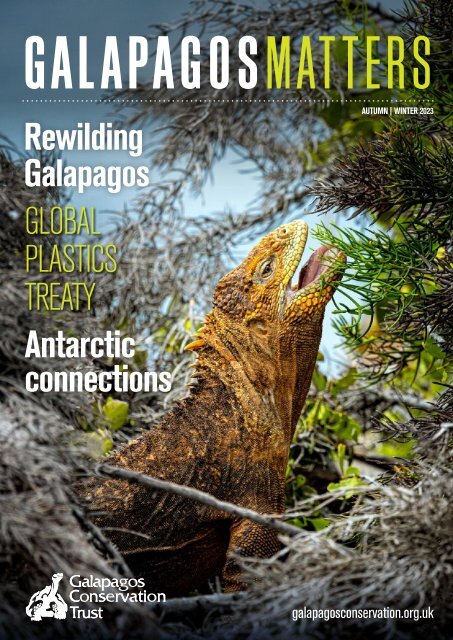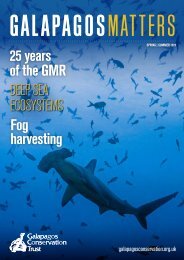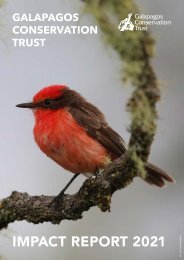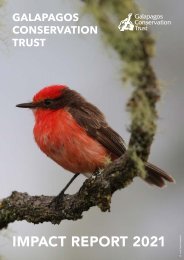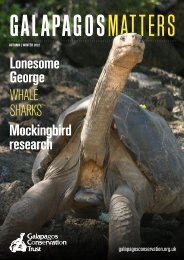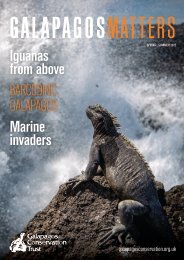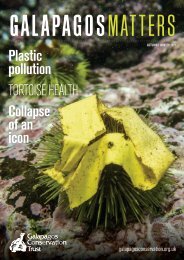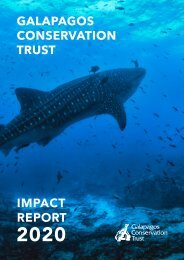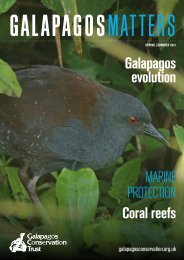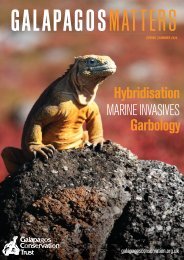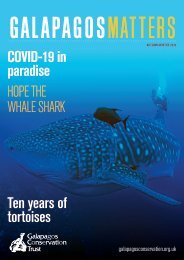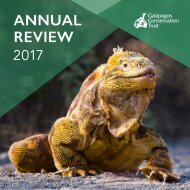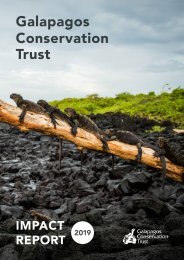Autumn/Winter 2023 - Galapagos Matters - Galapagos Conservation Trust
Create successful ePaper yourself
Turn your PDF publications into a flip-book with our unique Google optimized e-Paper software.
GALAPAGOSMATTERS<br />
Rewilding<br />
<strong>Galapagos</strong><br />
GLOBAL<br />
PLASTICS<br />
TREATY<br />
Antarctic<br />
connections<br />
AUTUMN | WINTER <strong>2023</strong><br />
galapagosconservation.org.uk
GALAPAGOSMATTERS<br />
CONTENTS<br />
Cover: <strong>Galapagos</strong> land<br />
iguanas are ecosystem<br />
engineers and create<br />
opportunities for other<br />
species on islands<br />
where they are present<br />
by opening up paths,<br />
removing soil and<br />
dispersing seeds.<br />
© Leighton Lum<br />
4-5 Wild <strong>Galapagos</strong><br />
6 -7 <strong>Galapagos</strong> News<br />
8 -11 Rewilding <strong>Galapagos</strong><br />
GCT’s Tom O’Hara explains how the removal of<br />
invasive species and the reintroduction of keystone<br />
species can restore habitats in <strong>Galapagos</strong>, making<br />
space for natural processes to take over and heal<br />
degraded island ecosystems, while Dr Paula<br />
Castaño tells us more about the next steps in the<br />
Archipelago’s most ambitious rewilding project,<br />
the restoration of Floreana island.<br />
12 Remembering Randal and Godfrey<br />
GCT’s new Chief Executive Jen Jones pays tribute<br />
to two pillars of the <strong>Galapagos</strong> conservation<br />
community that we sadly lost earlier this year:<br />
Randal Keynes OBE and Godfrey Merlen.<br />
13 Legends of <strong>Galapagos</strong> Appeal<br />
14 -15 Project Updates<br />
16 -17 GCT at the Global Plastics Treaty negotiations<br />
GCT’s Jess Howard reports back on the second<br />
round of negotiations for a future Global Plastics<br />
Treaty in Paris, and we interview Luis Vayas<br />
Valdivieso, one of the elected Chairs of the<br />
Intergovernmental Negotiation Committee, about<br />
the progress so far.<br />
18-19 Restoring Floreana: a local perspective<br />
GCT’s Kelly Hague visited Floreana last year,<br />
and saw first-hand the fantastic impact that the<br />
Restoring Floreana project is going to have for the<br />
people and wildlife that call the island their home.<br />
20-21 Supporter News & Membership<br />
22 Global Relevance<br />
<strong>Galapagos</strong> and Antarctica, two remote and<br />
seemingly very different regions of the globe, share<br />
some surprising connections and face many of the<br />
same challenges, as Jonathan Green explains.<br />
23 Events & Merchandise<br />
CONTRIBUTORS<br />
Dr Paula A.Castaño is a wildlife<br />
veterinarian who has been<br />
working with Island <strong>Conservation</strong><br />
since 2013, supported by GCT,<br />
to provide technical assistance<br />
to the <strong>Galapagos</strong> National Park<br />
on preventing extinctions and<br />
restoring ecosystems. She is<br />
currently part of the Restoring<br />
Floreana project, working as a<br />
Native Species Specialist and<br />
co-ordinating all environmental<br />
aspects of the project, including<br />
species reintroduction.<br />
Luis Vayas Valdivieso is Ecuador’s<br />
Ambassador to the UK and one of the<br />
elected Chairs of the Intergovernmental<br />
Negotiation Committee for the future<br />
international legally binding instrument<br />
on plastic pollution. He has nearly 30<br />
years of experience in government and<br />
diplomacy, and served as the Vice-<br />
President of the Conference of the<br />
Parties to the Basel, Rotterdam and<br />
Stockholm Conventions on protecting<br />
human health and the environment<br />
from hazardous chemicals and wastes.<br />
Jonathan Green is the founder and<br />
director of the <strong>Galapagos</strong> Whale<br />
Shark Project, and has worked<br />
for nearly three decades in the<br />
<strong>Galapagos</strong> Islands. He is an elected<br />
Fellow of the Royal Geographical<br />
Society in London, and when not in<br />
<strong>Galapagos</strong> he works on expedition<br />
vessels in the polar regions. He also<br />
teaches photography workshops in<br />
destinations around the world and<br />
has won several international awards.<br />
2 GALAPAGOS MATTERS
FROM THE<br />
CHIEF EXECUTIVE<br />
by Dr Jen Jones<br />
Iam honoured to have been<br />
appointed Chief Executive<br />
Officer at GCT, my ultimate<br />
dream job.<br />
After dedicating the last 12 years<br />
to <strong>Galapagos</strong> through my work with<br />
GCT as the Head of Programmes, my<br />
passion for the Islands, the wildlife<br />
and the wonderful people who live<br />
there has only grown with each new<br />
experience. The same is true of GCT,<br />
an organisation I have grown with,<br />
learned so much from and never fail<br />
to see the potential of. I would like<br />
to say a big thank you to the Board<br />
for placing their trust in me, to my<br />
predecessor Sharon Johnson for<br />
the strong foundations that she has<br />
built over the past eight years, and<br />
to GCT’s amazing staff, supporters<br />
and volunteers for everything that<br />
you do.<br />
We are at a pivotal point in our<br />
mission, with experience, evidence<br />
and connections coming together<br />
and allowing us to rapidly scale up<br />
our impact. We are being invited<br />
to sit at increasingly influential<br />
tables, representing voices from the<br />
Islands that deserve to be amplified<br />
– the result of more impactful<br />
programmes, communications and<br />
networking. This was exemplified by<br />
our recent attendance at the second<br />
round of negotiations on the future<br />
Global Plastics Treaty in Paris in May<br />
(p.16-17). This momentum is not<br />
a second too soon as we ramp up<br />
our efforts towards achieving global<br />
targets such as the United Nations<br />
Sustainable Development Goals by<br />
2030 in <strong>Galapagos</strong>.<br />
We are optimistic about the<br />
prospects of securing a strong<br />
Global Plastics Treaty, but we know<br />
that the power of the plastics and<br />
petrochemical lobby will present a<br />
major obstacle – coming together as<br />
civil society will be key to standing<br />
up for the planet. We face additional<br />
challenges over the coming months,<br />
from political upheaval in Ecuador<br />
to the return of El Niño conditions,<br />
which will have a big impact on<br />
the delicate balance of nature in<br />
<strong>Galapagos</strong>. In particular, we know<br />
that marine species will be hard<br />
hit by the warming of the seas<br />
around the Archipelago, making<br />
our ocean protection work a crucial<br />
focus. Thank you to everyone<br />
who supported our recent Ocean<br />
Protection Appeal and our Alberto<br />
the Waved Albatross storybook<br />
crowdfunder, and to those of you<br />
who attended our fascinating spring<br />
webinar with Jonathan and Sofía<br />
Green of the <strong>Galapagos</strong> Whale Shark<br />
Project. If you missed the event<br />
you can watch the recording on<br />
our YouTube channel, and you can<br />
also hear more from Jonathan on<br />
page 22.<br />
Since the last edition of <strong>Galapagos</strong><br />
<strong>Matters</strong>, we have sadly lost two of<br />
our dearest friends, Randal Keynes<br />
OBE and Godfrey Merlen. Both were<br />
GCT Ambassadors, hugely influential<br />
in the conservation of the Islands,<br />
and to me personally. We pay tribute<br />
to them both on page 12. We hope<br />
that in the coming years we will be<br />
able to realise their ambitions of<br />
reintroducing iconic species such<br />
as the little vermilion flycatcher and<br />
the Floreana mockingbird through<br />
restoring and rewilding the island<br />
ecosystems where they were once<br />
found, and we are launching a new<br />
appeal in their honour (p.13).<br />
The local community is key to the<br />
success of island restoration and<br />
rewilding projects, and Kelly writes<br />
movingly on pages 18-19 about<br />
her visit to Floreana last year. You<br />
can find out more about rewilding<br />
in <strong>Galapagos</strong> in our feature on<br />
pages 8-11, which I hope will whet<br />
your appetite for <strong>Galapagos</strong> Day at<br />
the Royal Geographical Society on<br />
19 October (p.23). We have some<br />
brilliant speakers lined up – I hope to<br />
see you there!<br />
© Jen Jones<br />
<strong>Galapagos</strong> <strong>Matters</strong> is a copyright<br />
biannual publication produced<br />
for members of <strong>Galapagos</strong><br />
<strong>Conservation</strong> <strong>Trust</strong>.<br />
The information in this issue was<br />
obtained from various sources, all<br />
of which have extensive knowledge<br />
of <strong>Galapagos</strong>, but neither GCT nor<br />
the contributors are responsible<br />
for the accuracy of the contents or<br />
the opinions expressed herein.<br />
ISSN 2050-6074 <strong>Galapagos</strong><br />
<strong>Matters</strong> is printed on paper<br />
made from well managed forests<br />
and controlled sources.<br />
Editor: Henry Nicholls<br />
Chief Executive: Jen Jones<br />
Communications Manager: Tom O’Hara<br />
Designer: The Graphic Design House<br />
Printer: Bishops Printers<br />
020 7399 7440<br />
gct@gct.org<br />
galapagosconservation.org.uk<br />
AUTUMN | WINTER <strong>2023</strong><br />
3
© Claire Waring<br />
4 GALAPAGOS MATTERS
WILD<br />
GALAPAGOS<br />
This dramatic image of a juvenile great frigatebird<br />
attacking a swallow-tailed gull by Claire Waring won<br />
overall first place in our <strong>Galapagos</strong> Photography<br />
Competition. Frigatebirds exhibit a behaviour known<br />
as kleptoparasitism, harassing other seabirds and<br />
forcing them to regurgitate their recently caught<br />
food by grabbing their tail feathers and shaking<br />
them, then catching the regurgitated food before<br />
it enters the sea.<br />
Our judges were impressed by the clarity and<br />
definition of this difficult shot to pull off, with BBC<br />
producer and director Jo Haley describing it as “full<br />
of energy and action”, while <strong>Galapagos</strong> naturalist<br />
guide Walter Perez commented that the image<br />
“shows that paradise can turn into hell!”<br />
Our <strong>2023</strong> competition was kindly sponsored by<br />
Mundy Adventures, and a selection of the top<br />
images chosen by our judging panel will feature in<br />
our 2024 calendar which is now available to pre-order<br />
(p.23). To see all the winners and runners-up, please<br />
visit galapagosconservation.org.uk/photographycompetition-galleries/<br />
AUTUMN | WINTER <strong>2023</strong><br />
5
GALAPAGOS<br />
NEWS<br />
ECUADOR SECURES<br />
WORLD’S BIGGEST<br />
‘DEBT FOR NATURE’ DEAL<br />
Scalloped hammerheads © Simon Pierce<br />
In April the Ecuadorian government<br />
announced a much anticipated<br />
‘debt for nature’ swap, which will see<br />
$1.6 billion of existing commercial<br />
debt converted into a new $656<br />
million loan, freeing up funds for<br />
the conservation of the <strong>Galapagos</strong><br />
Islands.<br />
Ecuador will repay the loan over 18<br />
years, and will contribute $12 million<br />
a year to conservation, as well as a<br />
further $5.4 million a year to create<br />
a permanent endowment, which will<br />
then be used to finance conservation<br />
activities in perpetuity.<br />
Belize, Barbados and the Seychelles<br />
have all concluded similar debt for<br />
nature swaps in recent years, but the<br />
Ecuadorian deal is by far the largest<br />
to date. The allocation of the new<br />
conservation funds will be overseen by<br />
a new body, the <strong>Galapagos</strong> Life Fund<br />
(GLF), which will be governed by an<br />
11-member board of directors that<br />
includes five Ecuadorian government<br />
ministers and six non-government<br />
representatives. The GLF’s brief is to<br />
address the impacts of overfishing,<br />
climate change and pollution on the<br />
Archipelago, supporting the work of<br />
the <strong>Galapagos</strong> National Park. Funding<br />
will be allocated to projects that help to<br />
strengthen the local economy, improve<br />
the management and enforcement of<br />
the <strong>Galapagos</strong> Marine Reserve and<br />
Hermandad Marine Reserve, support<br />
the development of more sustainable<br />
fisheries, and build climate resilience.<br />
HIGH SEAS TREATY<br />
AGREED AT THE UN<br />
There was a crucial breakthrough<br />
at the United Nations in March,<br />
as nations finally reached agreement<br />
on a High Seas Treaty after nearly 20<br />
years of negotiations. The treaty will<br />
put mechanisms in place to create<br />
Marine Protected Areas in parts of the<br />
ocean beyond national jurisdiction, a<br />
key component in realising the shared<br />
global goal of protecting 30% of the<br />
world’s oceans by 2030. The treaty will<br />
also govern marine research for both<br />
scientific and commercial purposes,<br />
and a new conference of the parties<br />
(COP) will meet periodically to monitor<br />
progress and hold signatories to<br />
account.<br />
6 GALAPAGOS MATTERS
STUDY SHOWS THAT<br />
CONSERVING WILDLIFE CAN HELP<br />
MITIGATE CLIMATE CHANGE<br />
Protecting wildlife could<br />
significantly enhance natural<br />
carbon capture, according to a study<br />
published in Nature Climate Change<br />
and co-authored by 15 scientists from<br />
eight countries. The research looked<br />
at nine species – marine fish, whales,<br />
sharks, grey wolves, wildebeest, sea<br />
otters, musk oxen, African forest<br />
elephants and American bison – and<br />
found that protecting or restoring their<br />
populations could allow the capture of<br />
an additional 6.41 billion tons of carbon<br />
dioxide per year. This constitutes 95% of<br />
the amount needed every year to meet<br />
the Paris Agreement target of keeping<br />
global temperature rise below 1.5C.<br />
You can read the study here:<br />
go.nature.com/3qp2j5U<br />
GLOBAL PLASTICS TREATY<br />
NEGOTIATIONS CONTINUE<br />
The GCT team attended the second<br />
round of negotiations on a future<br />
Global Plastics Treaty, which took<br />
place between 29 May and 2 June<br />
at UNESCO headquarters in Paris.<br />
Although the negotiations got off to a<br />
difficult start, with some oil- and plasticproducing<br />
nations delaying proceedings<br />
with procedural arguments around<br />
voting mechanisms, there was also<br />
some encouraging progress, with states<br />
agreeing to develop the first draft of the<br />
treaty text. Intersessional work on the<br />
‘zero draft’ will continue ahead of the<br />
third round of negotiations taking place<br />
in Nairobi in November. Read Jess’s<br />
article on page 16 for more reflections<br />
on the Paris talks.<br />
© GCT<br />
12 LITTLE VERMILION<br />
FLYCATCHER CHICKS FLEDGE<br />
The land bird conservation team at<br />
the Charles Darwin Foundation<br />
(CDF) has reported the most successful<br />
nesting season for little vermilion<br />
flycatchers on Santa Cruz since the<br />
management programme started in<br />
© Agustín Gutiérrez - CDF<br />
PRESIDENTIAL POLL GOES TO<br />
SECOND ROUND<br />
Ecuador’s presidential election<br />
will be decided by a run-off<br />
after frontrunner Luisa González<br />
failed to secure the 50% of the vote<br />
required to win the contest outright<br />
in August’s first round. She will face<br />
Daniel Noboa in the second round on<br />
15 October. Elections were triggered<br />
when President Guillermo Lasso<br />
dissolved the National Assembly in<br />
May, and take place against a backdrop<br />
of a deteriorating security situation in<br />
mainland Ecuador. A recent upsurge<br />
in violence has been fuelled by the<br />
drugs trade, and tensions remain high<br />
after presidential candidate Fernando<br />
Villavicencio was assassinated less than<br />
a fortnight before voters went to the<br />
polls. GCT will continue to monitor<br />
the situation and the implications for<br />
<strong>Galapagos</strong>.<br />
TOURIST ARRIVALS HIT RECORD HIGH<br />
March <strong>2023</strong> set a new record<br />
for monthly tourist numbers<br />
in <strong>Galapagos</strong>, with 32,509 arrivals<br />
according to the Ecuadorian Ministry<br />
of Tourism. The tourist industry in<br />
<strong>Galapagos</strong> has experienced a rapid<br />
post-pandemic recovery, and the<br />
<strong>Galapagos</strong> National Park Directorate<br />
recently announced that 267,688<br />
tourists visited the <strong>Galapagos</strong> Islands in<br />
2022, just 1% behind 2019 numbers.<br />
2018, with 12 juveniles successfully<br />
fledging following the <strong>2023</strong> nesting<br />
season. Scientists from CDF and the<br />
<strong>Galapagos</strong> National Park are working<br />
on the experimental restoration of the<br />
island’s Scalesia forest, a key habitat for<br />
this colourful but Vulnerable endemic<br />
bird, which is threatened by invasive<br />
species such as mora (hill raspberry) and<br />
the avian vampire fly (Philornis downsi).<br />
STUDY REVEALS GROWING<br />
‘PLASTIC SMOG’ IN OUR OCEANS<br />
There are more than 170 trillion<br />
plastic particles, weighing<br />
approximately 2 million tonnes,<br />
afloat in the world’s oceans, according<br />
to a study led by the 5 Gyres Institute<br />
and co-authored by Dr Martin Thiel, a<br />
member of our Pacific Plastics: Science<br />
to Solutions network. The study also<br />
showed a rapid acceleration in plastic<br />
densities in the world’s oceans since<br />
2005. Read the full paper here:<br />
bit.ly/5GyresPlasticsResearch<br />
SCIENTISTS DISCOVER PRISTINE<br />
DEEP-SEA CORAL REEFS IN GALAPAGOS<br />
An international team of scientists<br />
has discovered extensive,<br />
ancient deep-sea coral reefs in the<br />
<strong>Galapagos</strong> Marine Reserve (GMR), the<br />
first such discovery since the GMR was<br />
established in 1998. The <strong>Galapagos</strong><br />
Deep <strong>2023</strong> expedition, led by scientists<br />
at the Woods Hole Oceanographic<br />
Institution, University of Bristol,<br />
Boise State University and University<br />
of Essex, in collaboration with the<br />
<strong>Galapagos</strong> National Park Directorate,<br />
Charles Darwin Foundation and the<br />
Ecuadorian Navy’s Oceanographic<br />
and Antarctic Institute, made the<br />
discovery while exploring a previously<br />
unmapped seamount in the centre of<br />
the Archipelago on board the deep-sea<br />
research submersible Alvin.<br />
AUTUMN | WINTER <strong>2023</strong><br />
7
REWILDING<br />
GALAPAGOS<br />
by Tom O’Hara<br />
<strong>Galapagos</strong> giant tortoise © Ben Howitt<br />
R<br />
’ ewilding’ is a broad and not entirely scientific term, which has been used to<br />
describe everything from landscape-scale restoration of ecosystems to letting<br />
weeds grow wild in your garden.<br />
It has been the source of<br />
controversy, particularly when it<br />
entails land being taken out of food<br />
production, or the reintroduction of<br />
species such as wolves and beavers.<br />
Concerns have also been raised about<br />
local and indigenous communities being<br />
marginalised by rewilding projects, and<br />
the economic benefits of rewilding have<br />
been questioned by those who fear the<br />
loss of traditional rural industries.<br />
Yet the potential benefits of rewilding<br />
are enormous. There is a growing<br />
realisation that biodiversity loss needs to<br />
be reversed if we are to mitigate against<br />
the worst effects of climate change,<br />
and nations are now committed to<br />
protecting 30% of the world’s land and<br />
sea by 2030. Rewilding creates more<br />
space for nature, and allows natural<br />
processes to drive the restoration of<br />
damaged ecosystems, often with a little<br />
helping hand from humans.<br />
This may involve the removal of<br />
damaging invasive species, the creation<br />
of new habitat (e.g. by planting trees),<br />
or the reintroduction of locally extinct<br />
‘keystone species’. A combination<br />
of deliberate reintroductions and<br />
spontaneous recolonisation can help<br />
wildlife populations recover and boost<br />
biodiversity, which we now know is so<br />
crucial to the health of our planet, and<br />
there is also a growing body of evidence<br />
that rewilding brings economic benefits<br />
to local communities, particularly when<br />
applied to unproductive land that is<br />
poorly suited to agriculture. Rewilded<br />
land has a role to play in everything<br />
from carbon capture to preventing the<br />
transmission of zoonotic diseases, and<br />
can help to create a world in which<br />
humans thrive in balance with the<br />
natural world.<br />
But what does rewilding mean in<br />
the context of <strong>Galapagos</strong>, where 97%<br />
of the land is already a protected<br />
National Park?<br />
CONTROLLING<br />
INVASIVE SPECIES<br />
Today, despite strong biosecurity<br />
measures, there are estimated to be<br />
nearly 1,500 introduced species present<br />
in the <strong>Galapagos</strong> Islands. Among the<br />
most damaging are rats and feral cats,<br />
which predate on ground nesting birds,<br />
iguanas and the eggs of giant tortoises,<br />
while introduced herbivores such as<br />
The <strong>Galapagos</strong> rail has naturally<br />
recolonised Pinzon island © Ian Henderson<br />
goats can lay waste to vegetation.<br />
Less immediately obvious, but equally<br />
devastating, is the parasitic avian<br />
vampire fly, Philornis downsi. The<br />
larvae of this fly feed on the eggs<br />
and hatchlings of many species of<br />
<strong>Galapagos</strong> land bird, with up to 100%<br />
mortality in some nests. If we are to<br />
return the <strong>Galapagos</strong> Islands to a truly<br />
wild state, these invasive species need<br />
to be removed.<br />
We already know what a difference<br />
this will make from islands such as<br />
Pinzon, which was cleared of invasive<br />
rats in 2012 after many of its native<br />
8 GALAPAGOS MATTERS
species became extinct. Ten years later,<br />
there are promising signs of ecological<br />
recovery, and GCT is supporting our<br />
partners to deliver surveys to track this.<br />
Two species of bird – the <strong>Galapagos</strong><br />
rail and the cactus finch – have naturally<br />
recolonised the island, and Pinzon<br />
giant tortoises are reproducing in the<br />
wild again.<br />
GCT is addressing the impact of<br />
Philornis downsi through our support for<br />
the Mangrove Finch Project. In recent<br />
years, the team has been focusing<br />
on Philornis control in the wild. This<br />
includes injecting wild nests with an<br />
insecticide, which needs to be delivered<br />
by a highly skilled tree-climber, and<br />
trialling use of feather dispensers<br />
treated with an insecticide to see if<br />
breeding pairs will use these feathers as<br />
nest building materials.<br />
RESTORING HABITATS<br />
Invasive animal species are not the<br />
only barrier to rewilding the <strong>Galapagos</strong><br />
Islands. Since its introduction in 1968,<br />
the invasive hill raspberry (Rubus niveus)<br />
has spread across the Archipelago. In<br />
places, impenetrable spiny thickets<br />
grow up to three metres tall, turning<br />
agricultural areas into wasteland and<br />
preventing the unique native forest,<br />
dominated by the endemic daisy tree<br />
(Scalesia), from regenerating. The dense<br />
stands of vegetation have also been<br />
found to be preventing birds such as the<br />
little vermilion flycatcher from foraging<br />
on the ground for food.<br />
We are supporting the Landbird<br />
<strong>Conservation</strong> Programme, led by<br />
the Charles Darwin Foundation and<br />
the <strong>Galapagos</strong> National Park, which<br />
is investigating a number of ways<br />
to reverse the decline of endemic<br />
land birds. This includes research<br />
into potential biocontrol methods to<br />
<strong>Galapagos</strong> National Park plant nursery © Shannon D’Arcy<br />
remove the hill raspberry, for example<br />
by introducing a rust fungus from the<br />
plant’s native range to weaken it and<br />
reduce its impact. Current control<br />
methods entail a mixture of manual<br />
labour and herbicide application,<br />
but the plant’s fast growth and large<br />
seedbank make these methods<br />
expensive and labour-intensive.<br />
Research has also shown that natural<br />
regeneration of Scalesia pedunculata<br />
forest is limited following the removal<br />
of the invasive plants, so the team<br />
is helping to restore the flycatchers’<br />
habitat by planting saplings.<br />
REINTRODUCING<br />
KEYSTONE SPECIES<br />
The ecologist Robert Paine coined<br />
the term ‘keystone species’ in the 1960s<br />
to describe those species that exert a<br />
significant effect on the composition of<br />
an ecosystem. When a keystone species<br />
is removed from an ecosystem, that<br />
ecosystem is dramatically altered, and<br />
may even collapse. There are generally<br />
considered to be three different types of<br />
keystone species: predators, mutualists<br />
and ecosystem engineers.<br />
Predators such as sharks control the<br />
populations of their prey, which in turn<br />
can have effects further down the food<br />
chain, in what is known as a ‘trophic<br />
cascade’. Mutualists provide benefits<br />
for other species as part of a symbiotic<br />
relationship. The most obvious example<br />
is pollinators such as bees, which both<br />
feed on the plants that they pollinate,<br />
and also enable those plants to<br />
reproduce and spread. An ecosystem<br />
engineer is a species that can create,<br />
modify, maintain or destroy a habitat,<br />
which in turn can benefit (or harm)<br />
other species. Perhaps the best-known<br />
example of an ecosystem engineer is<br />
the beaver, with its remarkable ability<br />
to slow rivers, restore woodlands and<br />
create wetland habitats through felling<br />
trees and building dams.<br />
Mangrove finch © Michael Dvorak<br />
AUTUMN | WINTER <strong>2023</strong><br />
9
The most iconic <strong>Galapagos</strong> species<br />
of all, the giant tortoise, is an important<br />
ecosystem engineer. Tortoises shape<br />
their habitats by grazing on plants,<br />
dispersing seeds and trampling<br />
vegetation. They play an important<br />
role in germinating seeds, as well as<br />
in thinning out and opening up new<br />
areas of ground for different types of<br />
vegetation to grow.<br />
For evidence of these processes<br />
at work, we just have to look at the<br />
reintroduction of giant tortoises to Santa<br />
Fe. This small island once had its own<br />
endemic species of tortoise, which went<br />
extinct in the mid-19th century due to<br />
overexploitation by humans. The island’s<br />
ecosystem was then ravaged by the<br />
introduction of feral goats, which caused<br />
severe soil erosion and changes in the<br />
structure of the vegetation. A successful<br />
eradication programme removed the<br />
goats in the 1970s, but the continuing<br />
absence of tortoises limited the ability<br />
of the ecosystem to recover.<br />
Following genetic evaluation of<br />
tortoise bones on the island, a decision<br />
was made to introduce the closest living<br />
relative of the Santa Fe tortoise to the<br />
island as a proxy for the extinct species.<br />
Between 2015 and 2020, a total of 551<br />
juvenile and 31 subadult tortoises from<br />
Española island (Chelonoidis hoodensis)<br />
were translocated to Santa Fe, and by<br />
2020 they had successfully colonised<br />
around 10% of the island. Most<br />
promisingly, the population of both<br />
the Opuntia echios cactus (a keystone<br />
species for many organisms on the<br />
island) and the land iguana subspecies<br />
Conolophus pallidus were shown to<br />
have increased following the arrival of<br />
the tortoises.<br />
Findings such as these support<br />
the reintroduction of large-bodied<br />
reptilian herbivores as a key component<br />
of restoring island ecosystems in<br />
<strong>Galapagos</strong>, and we expect to see<br />
similar results from the reintroduction<br />
of land iguanas to Santiago island,<br />
a project supported by GCT over<br />
a number of years. Iguanas were<br />
Santa Fe land iguana © Kevin Fraser<br />
reintroduced in 2019 after an absence<br />
of more than a century, and are now<br />
successfully breeding, with the island<br />
already showing positive environmental<br />
changes. The iguanas open up paths,<br />
remove soil and disperse seeds, and<br />
changes in population dynamics create<br />
greater food availability for others, with<br />
endemic species such as <strong>Galapagos</strong><br />
hawks likely to return over the next<br />
few years.<br />
SUPPORTING LOCAL<br />
COMMUNITIES<br />
As we reported in the last issue of<br />
<strong>Galapagos</strong> <strong>Matters</strong>, we are currently<br />
scoping a new project to rewild marginal<br />
agricultural land in the highlands of Santa<br />
Cruz. This land could act as a ‘buffer<br />
zone’ between the agricultural zone<br />
and the National Park, creating more<br />
space for nature and allowing land to<br />
recover from damage sustained due to<br />
overgrazing, cultivation of introduced<br />
crops and the use of pesticides. Together<br />
with more wildlife-friendly methods of<br />
farming, this can also mitigate the spread<br />
of disease between wildlife, domestic<br />
animals and humans, and limit the<br />
spread of antibiotic-resistant bacteria.<br />
We are partnering with local NGO<br />
Fundación Un Cambio por la Vida<br />
to support landowners and local<br />
community leaders who want to rewild<br />
their land, and we want to support<br />
young islanders to experience nature<br />
through involvement with rewilding.<br />
We also believe that these projects can<br />
create sustainable jobs in conservation,<br />
regenerative farming and ecotourism,<br />
and allow humans to thrive alongside<br />
nature on the populated islands. This, we<br />
believe, is the only way to guarantee the<br />
long-term survival of the unique wildlife<br />
and natural beauty of <strong>Galapagos</strong>.<br />
Treating vermilion flycatcher nests<br />
© Agustin Gutierrez - CDF<br />
Scalesia pedunculata © Patricia Jaramillo - CDF<br />
Participants in the Floreana workshop, July 2022 © GNPD<br />
GALAPAGOS<br />
DAY <strong>2023</strong><br />
Find out more about rewilding<br />
and restoring island habitats,<br />
including our plans for the<br />
highlands of Santa Cruz, at<br />
<strong>Galapagos</strong> Day <strong>2023</strong>.<br />
See page 23 for more details.<br />
10 GALAPAGOS MATTERS
RESTORING FLOREANA:<br />
A PLAN FOR THE REINTRODUCTION OF LOCALLY EXTINCT SPECIES<br />
by Dr Paula A. Castaño<br />
Floreana is home to an array of<br />
unique species, some endemic<br />
to the island, such as the medium<br />
tree finch, and others endemic to the<br />
Archipelago, like the <strong>Galapagos</strong> petrel,<br />
which has its largest breeding colony<br />
on Floreana. But these unique species<br />
are not alone in paradise. Mammals,<br />
including the house mouse, black rat<br />
and feral cats, in addition to other<br />
species such as the avian vampire fly<br />
(Philornis downsi), introduced by people<br />
at different stages in the island’s human<br />
history, became invasive, negatively<br />
impacting wildlife populations and<br />
the island’s food security. This has<br />
resulted in 54 species present on<br />
Floreana being listed as globally<br />
threatened by the International Union<br />
for <strong>Conservation</strong> of Nature (IUCN), with<br />
at least two of these species classified<br />
as Critically Endangered, suggesting<br />
a high likelihood of extinction within<br />
our lifetime.<br />
But there is hope. The <strong>Galapagos</strong><br />
National Park Directorate (GNPD),<br />
the Agency for the Regulation and<br />
Control of Biosecurity and Quarantine<br />
for <strong>Galapagos</strong> (ABG) and the<br />
Floreana community, with technical<br />
assistance from Fundación JocoToco,<br />
Island <strong>Conservation</strong>, Durrell Wildlife<br />
<strong>Conservation</strong> <strong>Trust</strong> and other partners<br />
and funders such as <strong>Galapagos</strong><br />
<strong>Conservation</strong> <strong>Trust</strong>, are working hard<br />
to protect Floreana’s native species<br />
through the implementation of the<br />
Floreana Island Ecological Restoration<br />
Project, which aims to remove invasive<br />
rodents and feral cats from Floreana<br />
in <strong>2023</strong>.<br />
Once invasive rodents and feral cats<br />
are removed from the island, Floreana’s<br />
unique fauna and flora will have greater<br />
opportunity to recover and flourish.<br />
But these restoration and rewilding<br />
efforts require careful planning. In<br />
July 2022, after several years of<br />
planning and collaboration among<br />
the Floreana Ecological Restoration<br />
Project partnership and supporters,<br />
we finally gathered on Floreana at a<br />
three-day workshop led by the GNPD.<br />
The goal was to create a collaborative<br />
environment to understand the<br />
requirements for reintroducing all<br />
extirpated species to Floreana once<br />
invasive predators are removed and<br />
establish a mutually agreed upon<br />
plan for this ambitious conservation<br />
endeavour. This plan spans beyond<br />
the next five years with the first three<br />
to five species (including the Floreana<br />
mockingbird) returning to the island,<br />
possibly in 2024 and 2025, while other<br />
species such as the <strong>Galapagos</strong> hawk<br />
will return only when other reintroduced<br />
species populations have become<br />
established.<br />
Furthermore, all stakeholders agreed<br />
on the end goal: restoring an ecosystem<br />
unlike anywhere else on the planet,<br />
where communities continue to thrive<br />
together with nature.<br />
This workshop<br />
was of great<br />
importance and<br />
a great challenge<br />
to determine<br />
strategies for<br />
reintroducing<br />
locally extinct species<br />
on Floreana. During the workshop,<br />
it was evident the great interest that<br />
all the participants had in being able<br />
to contribute to this remarkable<br />
conservation project, regardless of<br />
the challenges that await us. As a Park<br />
Ranger, it is another commitment and<br />
challenge that I am willing to face<br />
in order to protect and restore the<br />
ecosystems of <strong>Galapagos</strong>.<br />
I was invited to a workshop by<br />
Island <strong>Conservation</strong>, an NGO<br />
dedicated to conservation in the<br />
<strong>Galapagos</strong>, and by my institution,<br />
the <strong>Galapagos</strong> National Park,<br />
to create an action plan for<br />
reintroducing native and endemic<br />
species of the <strong>Galapagos</strong> Islands.<br />
This opportunity was significant for me and my<br />
colleagues. The speakers and experts attending the<br />
workshop shared their knowledge on the topics being<br />
discussed, allowing me to improve my conservation<br />
knowledge as a Park Ranger. This experience was<br />
very satisfactory since it strengthened my ability to<br />
continue supporting all the future work to be carried<br />
out to restore Floreana. Everyone’s involvement was<br />
critical to help the future reintroductions of these<br />
species. I learned a lot, and I am very grateful for<br />
being part of this project.<br />
Wilson Cabrera, Invasive Species<br />
Eradication Specialist, <strong>Galapagos</strong><br />
National Park<br />
Fidelino Gaona, Park Ranger and Avian<br />
Specialist, <strong>Galapagos</strong> National Park<br />
AUTUMN | WINTER <strong>2023</strong><br />
11
REMEMBERING<br />
RANDAL AND GODFREY<br />
by Jen Jones<br />
E<br />
arlier this year we lost two very special members of the <strong>Galapagos</strong> conservation community and<br />
long-standing GCT Ambassadors: Randal Keynes OBE and Godfrey Merlen.<br />
planes and boats to campaigning for an end to whaling and<br />
wildlife trafficking, he drove so much change for the benefit of<br />
the Islands, often pioneering new approaches to conservation<br />
that hadn’t even crossed the minds of others.<br />
GCT is honoured to have had Godfrey as an Ambassador<br />
since we began in the 1990s, and all who worked with him<br />
were inspired deeply by his love for nature and his wisdom of<br />
conservation. He had many friends and colleagues all over the<br />
world who will miss him dearly.<br />
Godfrey was a true voice for nature – we must continue to<br />
deliver his vision for a <strong>Galapagos</strong> where humans and nature<br />
thrive in harmony.<br />
Randal Keynes at Down House © GCT<br />
first met Randal Keynes in 2011. A smiling, unassuming<br />
I gentleman keen to share his knowledge and stories, he<br />
was already a stalwart for GCT and someone high on my<br />
list of ‘<strong>Galapagos</strong> All Stars’ to meet when I first started.<br />
A skilled raconteur, Randal delighted in telling little known<br />
stories about Charles Darwin, his great great grandfather and<br />
object of much dedicated study. One of his main missions was<br />
to humanise Darwin and increase relatability with the general<br />
public, moving away from the image of the old, bearded<br />
sombre scientist to a real person (who was young once!) with<br />
many facets. I remember the twinkle in Randal’s eye as he<br />
spoke about the drawings Darwin kept that were done by<br />
his young children, littered amongst his copious scientific<br />
notes, and how he made a slide for them in his home at Down<br />
House. How he was fascinated by earthworms and pigeons<br />
and barnacles.<br />
Replicating some of Darwin’s experiments to supplement<br />
learning was a big element of Randal’s pioneering education<br />
work, another of his passions through the Charles Darwin<br />
<strong>Trust</strong>, aiming to promote ‘Darwin-inspired learning’ –<br />
highlighting the value of taking the time to truly observe,<br />
record and reflect in nature. Randal was very influential in the<br />
development of GCT’s Discovering <strong>Galapagos</strong> educational<br />
websites and a big supporter of getting local children out to<br />
connect with nature, benefitting from the same wonderful wild<br />
experience that many tourists get from visiting the Islands.<br />
Godfrey Merlen had lived in <strong>Galapagos</strong> since the 1970s<br />
(arriving around the time Lonesome George was found on<br />
Pinta island), and he leaves an amazing legacy in conservation<br />
impact. From pushing for greater invasive species control on<br />
Do not expect anything. Just go<br />
with an open mind and unexpected<br />
surprises will greet you wherever you<br />
look. But remember to look and don’t<br />
hurry by… Live the journey, for the<br />
destination may not be the expected<br />
one! It is always worth keeping in<br />
touch with <strong>Galapagos</strong>…<br />
Godfrey Merlen<br />
Godfrey Merlen © Stephanie Foote<br />
12 GALAPAGOS MATTERS
APPEAL<br />
HONOURING THE<br />
LEGENDS OF<br />
GALAPAGOS<br />
by Tom O’Hara<br />
Floreana mockingbirds © Luis Ortiz-Catedral<br />
The conservation of the <strong>Galapagos</strong><br />
Islands is a collective endeavour<br />
that unites people from all walks of<br />
life, from scientists who have spent<br />
their entire professional careers<br />
working on the Islands, to the rapt<br />
viewers of David Attenborough<br />
documentaries who have only<br />
ever glimpsed the Archipelago’s<br />
incredible wildlife on TV.<br />
Protecting one of the world’s greatest<br />
natural treasures is by necessity a<br />
collaborative effort. Nevertheless,<br />
throughout the Islands’ history<br />
there have always been visionaries<br />
and leaders who have stood out,<br />
inspirational figures who have found<br />
creative solutions to challenges that<br />
have at times seemed insurmountable.<br />
As we find ourselves at a crucial<br />
juncture in the fate of our natural world,<br />
we can again draw courage from those<br />
who have shown us the way forward in<br />
the past.<br />
Our great friend Felipe Cruz, who<br />
sadly passed away in 2018, was born<br />
on Floreana island to one of the first<br />
Sir David Attenborough and Felipe Cruz in 2009<br />
© Richard Lewisohn<br />
families to settle in <strong>Galapagos</strong>. Felipe<br />
was a passionate conservationist,<br />
driven to protect his home Islands and<br />
their unique biodiversity for future<br />
generations. In <strong>2023</strong> the restoration<br />
of Floreana reaches a critical point, as<br />
we prepare for the reintroduction of<br />
12 locally extinct species. This project<br />
meant so much to Felipe, and will make<br />
a real difference not just for the wildlife,<br />
but for the friends and loved ones that<br />
he left behind (as you can read on<br />
pages 18 - 19).<br />
Randal Keynes was also passionate<br />
about the restoration of Floreana, and<br />
particularly the plight of the Floreana<br />
mockingbird. There are only a few<br />
hundred of these birds left in the<br />
world, clinging on to a tiny amount of<br />
habitat on two islets off the coast of<br />
Floreana. Randal gave a lot of his time<br />
and effort to support preparations for<br />
their reintroduction over the last two<br />
decades, and we hope that we will soon<br />
reach a point where we see these birds<br />
back on their home island. On that day,<br />
there will be many of us thinking of<br />
Randal.<br />
Godfrey Merlen was instrumental in<br />
beginning the work to save the little<br />
vermilion flycatcher, one of the most<br />
charismatic and well-loved bird species<br />
in <strong>Galapagos</strong>, which is already extinct<br />
on Floreana and faces the same threat<br />
on Santa Cruz. In 2020, Godfrey wrote<br />
movingly in this magazine about why<br />
the fate of this little red bird matters:<br />
“It is not just the maintenance of an<br />
endemic species, a part of the unique<br />
biodiversity of <strong>Galapagos</strong>. It is a matter<br />
of the heart, the inspiration of life to<br />
highland farmers, to all those who take<br />
the time to visit the mists pervading the<br />
forest of Scalesia daisy trees, a magical<br />
place, very far from the madding world,<br />
yet saving our minds and souls.”<br />
Restoring and rewilding the<br />
islands that inspired these legends<br />
of <strong>Galapagos</strong> gives us a unique<br />
opportunity: to leave a small but<br />
significant part of the world in a better<br />
state than that in which we found it.<br />
It also allows us to harness the potential<br />
of young local conservationists – the<br />
legends of tomorrow – who are working<br />
to secure a better future for their Islands.<br />
As we honour the legacy of Felipe,<br />
Randal, Godfrey and the many others<br />
who we have loved and lost, we should<br />
ask ourselves: what do we want our<br />
legacy to be?<br />
Can you help us restore and rewild<br />
the Islands?<br />
£25 could provide a week’s bird feed<br />
for a finch in captivity while invasive<br />
mammals are eradicated on Floreana<br />
£50 could provide materials for<br />
interactive Tessa the Giant Tortoise<br />
reading sessions with primary school<br />
students<br />
£75 could fund a day of clearing<br />
invasive hill raspberry plants from<br />
vermilion flycatcher habitat<br />
Please donate whatever<br />
you can by using the form<br />
on the back page, visiting<br />
galapagosconservation.org.uk/<br />
donate or calling us on<br />
020 7399 7440<br />
AUTUMN | WINTER <strong>2023</strong><br />
13
PROJECT<br />
UPDATES<br />
CREATING A CIRCULAR ECONOMY FOR PLASTICS IN GALAPAGOS<br />
© GCT<br />
P<br />
lastic pollution is a huge global problem that is affecting almost every habitat that has been<br />
investigated, from the Mariana Trench in the deep ocean to the top of Mount Everest. Only 9% of<br />
plastic produced globally is recycled, while 12% is incinerated and 79% is discarded into landfills. It is clear<br />
that a paradigm shift is needed in our relationship with plastics.<br />
Plastic pollution threatens more<br />
than 40 species in the <strong>Galapagos</strong><br />
Islands due to the risk of ingestion<br />
or entanglement, and there is now<br />
an urgent need to embrace circular<br />
economy approaches and reduce<br />
plastic waste at source. The circular<br />
economy concept is defined as the need<br />
for a systemic shift from the traditional<br />
linear ‘cradle-to-grave’ economy to a<br />
circular system that reduces waste and<br />
leakage, embracing the ‘4Rs’ concept<br />
(reduce, reuse, recycle, recover).<br />
In January this year, GCT embarked<br />
on a new plastics circular economy<br />
project in <strong>Galapagos</strong>. The project aims<br />
to deliver prevention measures for local<br />
plastic pollution in <strong>Galapagos</strong>, including<br />
reducing imports, consumption and<br />
leakage, supported by community<br />
solutions for single-use plastic<br />
alternatives, whilst informing sustainable<br />
policies and supporting reduced risk<br />
to wildlife.<br />
The project is funded by the<br />
Norwegian Retailers’ Environment Fund,<br />
Norway’s largest private environmental<br />
fund, which supports national and<br />
international projects that reduce plastic<br />
pollution, increase plastic recycling<br />
and reduce the consumption of plastic<br />
bags. It is also Norway’s most important<br />
measure in complying with the EU<br />
Plastic Bags Directive.<br />
One of the aims of the project is to<br />
strengthen the international case for<br />
stronger plastic pollution legislation, by<br />
supporting Ecuador to provide a bestpractice<br />
example of a plastics circular<br />
economy in the <strong>Galapagos</strong> Islands and<br />
set an example to other areas, starting<br />
with action on single-use plastics. It also<br />
aims to provide new livelihoods within<br />
a circular economy, and will empower<br />
community innovators to implement<br />
their single-use plastic solutions.<br />
In partnership with our partners<br />
Fundación Un Cambio por la Vida and<br />
the <strong>Galapagos</strong> Hub, we plan to launch<br />
the project with the local community,<br />
combining community engagement with<br />
policy, advocacy and business activity.<br />
The aim is to develop a multi-pronged<br />
approach that will reduce single-use<br />
plastic bags for grocery shopping in<br />
<strong>Galapagos</strong>, and thus tackle one of the<br />
major sources of plastic waste on the<br />
Islands.<br />
We will be calling on members of<br />
the community (residents, tourists,<br />
shopkeepers and market owners/<br />
organisers) to help build and inform<br />
the trial of three interventions aiming<br />
to reduce the consumption of singleuse<br />
plastic bags. We will combine<br />
interactive community engagement<br />
and behavioural science to understand<br />
existing behaviours, viability of<br />
alternative solutions and how to<br />
encourage and engage the community<br />
with those solutions.<br />
Solutions will be trialled between<br />
February and April 2024 and will<br />
comprise alternative products or<br />
systems, designed and trialled in an<br />
iterative process with the community,<br />
establishing trust and uniting science,<br />
community and policy.<br />
14 GALAPAGOS MATTERS
SHARK DAY <strong>2023</strong><br />
On 15 July the <strong>Galapagos</strong> Science Center, in<br />
partnership with many other community partners,<br />
ran their tenth annual Shark Day event on San Cristobal<br />
island. San Cristobal is the fifth largest and easternmost island<br />
of <strong>Galapagos</strong>, and its 5,400 residents constitute the second<br />
largest human population.<br />
Over the past decade, the team has worked hard to raise<br />
awareness about the importance of sharks. The ‘Science in the<br />
Family’ event focusses on intergenerational learning, making<br />
games as fun and interactive as possible, and the aim of the<br />
day is to promote greater knowledge about conservation<br />
and inspire the community to take concrete action to protect<br />
sharks and other marine life.<br />
Thanks to the help of volunteers and community partners<br />
the tenth anniversary event was hugely successful. Over<br />
500 people attended to learn about the importance of<br />
sharks to marine ecosystems and how we can take care of<br />
them. Children had the opportunity to participate in varied<br />
interactive games, where they explored and learned about<br />
the internal structure of these fascinating marine predators. In<br />
addition, the children also enjoyed reading GCT’s educational<br />
storybook Marti the Hammerhead Shark. Marti’s story is based<br />
on research carried out by MigraMar (supported by GCT) over<br />
many years, tracking the journeys of sharks from their nursery<br />
areas in <strong>Galapagos</strong> to the seamounts of the Pacific Ocean.<br />
Shark Day <strong>2023</strong> © <strong>Galapagos</strong> Science Center<br />
IMPORTANT SHARK AND RAY<br />
AREAS (ISRAS)<br />
The IUCN Red List of<br />
Threatened Species now<br />
estimates that over one third<br />
of sharks and rays are at risk<br />
of extinction. The situation<br />
is particularly acute in coastal<br />
habitats where 75% of threatened<br />
species are found. The IUCN<br />
Species Survival Commission Shark<br />
Specialist Group has identified<br />
Important Shark and Ray Areas<br />
(ISRAs) to ensure that discrete<br />
portions of habitats, critical to shark<br />
species, are delineated to enhance<br />
protection.<br />
Earlier this year we were notified<br />
that nursery grounds in <strong>Galapagos</strong><br />
were designated as some of the<br />
first ISRAs in the world, including<br />
sites around San Cristobal where<br />
GCT has been supporting research<br />
for the past five years. This is<br />
fantastic news, and an important<br />
first step to conserving vulnerable<br />
shark and ray populations and<br />
other species that rely on sheltered<br />
mangrove lagoons in their lifecycle.<br />
White spotted eagle ray © Carlos Luna<br />
AUTUMN | WINTER <strong>2023</strong><br />
15
From L-R - Dr Sam Garrard (Plymouth Marine Laboratory/PPSS) and GCT’s Jess Howard, Dr Jen Jones, Kelly Hague and Lucía Norris © GCT<br />
GCT AT THE GLOBAL PLASTICS<br />
TREATY NEGOTIATIONS<br />
by Jess Howard<br />
E<br />
arlier this year, GCT attended the second round of negotiations for a global agreement to end plastic<br />
pollution at UNESCO headquarters in Paris.<br />
We were in Paris to provide<br />
evidence of the harms being<br />
caused by plastic pollution, and to<br />
represent our Pacific Plastics: Science<br />
to Solutions (PPSS) partners across<br />
<strong>Galapagos</strong> and the wider Eastern<br />
Pacific region.<br />
For the past five years, we have been<br />
gathering a wealth of evidence about<br />
the sources and impacts of plastic<br />
pollution washing into <strong>Galapagos</strong> and<br />
testing locally relevant solutions. We are<br />
using our research to support calls for a<br />
strong treaty and a global commitment<br />
to reducing single-use plastics, backed<br />
up by some of our key findings:<br />
• Over 2,500 microplastics were found<br />
per m 2 on the most polluted beaches<br />
in <strong>Galapagos</strong>, which are very difficult<br />
to clean<br />
• 69% of plastic items found on<br />
<strong>Galapagos</strong> coastlines are single-use<br />
items, and one third of those items<br />
are linked to drinks<br />
• 20% of plastic pollution globally is<br />
from maritime sources, whereas in<br />
<strong>Galapagos</strong> 40% comes from maritime<br />
sources<br />
• More than 95% of plastic found on<br />
<strong>Galapagos</strong> coastlines is likely to<br />
originate from outside the <strong>Galapagos</strong><br />
Marine Reserve<br />
These negotiations marked<br />
the second meeting of the<br />
Intergovernmental Negotiating<br />
Committee (INC-2) for the Global<br />
Plastics Treaty. The timeline is tight, and<br />
the aim is to complete negotiations by<br />
the end of 2024. This reflects the global<br />
ambition for this treaty, accelerated<br />
and supported by countries including<br />
Ecuador, Peru, the UK, Rwanda and<br />
Senegal.<br />
Outside of the plenary room, where<br />
discussions were held until the early<br />
hours of the morning, the GCT team<br />
was busy making strong connections<br />
with key players working to tackle<br />
plastic pollution with real solutions.<br />
16 GALAPAGOS MATTERS
GCT, along with our international<br />
research network (PPSS), was invited to<br />
share our positions at a GRULAC (Latin<br />
American countries and the Caribbean<br />
group) meeting. We also joined efforts<br />
with more than 20 NGOs and networks<br />
working in Latin America, to submit a<br />
joint statement that was read during<br />
the plenary.<br />
The week started slowly, with<br />
seemingly endless debates on the<br />
rules of procedure, delaying delegates<br />
from discussing the actual content of<br />
the treaty. This tactic seemed to be<br />
an attempt by countries with special<br />
interests in oil and plastic production<br />
to stall meaningful discussions and<br />
weaken the resulting treaty. Ultimately,<br />
however, the negotiations ended with<br />
some positive action. Delegates agreed<br />
to develop a ‘zero draft’ of the treaty<br />
– a full draft that will form the basis of<br />
discussions during the next round of<br />
negotiations in Nairobi in November<br />
<strong>2023</strong> (INC-3).<br />
GCT is calling on world leaders to<br />
agree an ambitious, legally binding<br />
Global Plastics Treaty that addresses<br />
social inequalities and ends plastic<br />
pollution by building an innovative<br />
circular economy rooted in evidence,<br />
that protects humans and biodiversity,<br />
and promotes human rights and<br />
environmental justice.<br />
Our message to delegates is to lead<br />
the way towards a world free from<br />
plastic pollution. Don’t delay or hesitate,<br />
don’t wait for the treaty, be ahead of the<br />
curve. There’s no time to waste, and we<br />
need global action now.<br />
Luis Vayas Valdivieso © Kiara Worth | IISD - ENB<br />
While we were in Paris, we spoke with<br />
Ambassador Luis Vayas Valdivieso,<br />
Ecuador’s Ambassador to the UK<br />
and one of the elected Chairs of<br />
the Intergovernmental Negotiation<br />
Committee.<br />
Can you explain what has been<br />
discussed at INC-2, what will you<br />
hope to discuss at INC-3, and how<br />
we, as civil society, scientists and<br />
community groups, can support you<br />
and other delegations to build a<br />
strong and binding plastics treaty?<br />
We are currently working on a ‘zero<br />
draft’, a text that will be used to create<br />
the future treaty. The mandate that we<br />
want from this negotiation is a text for<br />
the inter-sessional discussions. Now,<br />
the second part of your question is<br />
of great importance. Ecuador has<br />
been one of the leading countries in<br />
proposing that civil society and NGOs,<br />
and the scientific community should<br />
all participate. We already have great<br />
communication and strong links with<br />
the scientific community; they are the<br />
experts in the matter.<br />
What we would like to see now<br />
is a formal relationship with these<br />
stakeholders, meaning the scientific<br />
community, both during the<br />
negotiations and hopefully later on<br />
with the implementation of the treaty.<br />
We need data, we need information,<br />
and we need more scientific evidence.<br />
We have evidence already, but it’s still<br />
developing, and every day we know<br />
more about how dangerous plastic<br />
pollution is, both for the environment<br />
and also for human health.<br />
We know the Ecuadorian delegation<br />
is proposing for the Global Plastics<br />
Treaty to be signed in <strong>Galapagos</strong>,<br />
and for it to be called the ‘<strong>Galapagos</strong><br />
Treaty’. Why is it important for the<br />
world to sign this once-in-a-lifetime<br />
treaty in <strong>Galapagos</strong>?<br />
Ecuador has received this suggestion<br />
from different organisations, and from<br />
other countries as well. As you know,<br />
<strong>Galapagos</strong> is fragile, and it is suffering<br />
like other islands in the world from<br />
plastic pollution. Ninety-six percent of<br />
the plastic pollution that we receive<br />
in the <strong>Galapagos</strong> Islands comes from<br />
abroad. Although Ecuador is making<br />
great efforts to protect the Islands,<br />
and we have specific legislation for the<br />
<strong>Galapagos</strong> Islands, it is not enough.<br />
We even have regional efforts together<br />
with Colombia, Panama and Costa Rica,<br />
with CMAR (the Eastern Tropical Pacific<br />
Marine Corridor) – but unfortunately,<br />
it is still not enough. We need global<br />
solutions for global problems, and this is<br />
a global problem.<br />
Treaties, conventions and agreements<br />
are always signed in a distinctive and<br />
representative place. We have the<br />
Stockholm Convention, the Basel<br />
Convention, the Rotterdam Convention,<br />
we have the Paris Agreement on climate<br />
change, so we have proposed that<br />
<strong>Galapagos</strong> should be the place to sign<br />
this treaty. The <strong>Galapagos</strong> Treaty is more<br />
than just a name, it is what we want to<br />
show to the international community:<br />
that we need to fight against plastic<br />
pollution to preserve places like the<br />
<strong>Galapagos</strong> Islands.<br />
Finally, could you please tell us<br />
about the specific problem of plastic<br />
pollution from fisheries?<br />
This is a notorious problem that<br />
we are currently making a priority in<br />
these negotiations. Fisheries, or fishing<br />
gear, are polluting the environment<br />
in alarming amounts. Here’s some<br />
data – 29% of all fishing lines that are<br />
produced end up in the oceans. Six<br />
percent of fishing nets end up in the<br />
water, accidentally or deliberately.<br />
Almost 560 species are endangered<br />
because of the fishing gear that winds<br />
up in the ocean. We have a lot of room<br />
for improvement. There is already plenty<br />
of discussion about this, but in Ecuador,<br />
we believe there needs to be even<br />
more conversation and awareness of<br />
the problems surrounding fishing gear.<br />
There needs to be a change in how<br />
we manufacture those items, which are<br />
produced with plastic and are severely<br />
polluting the ocean. And lastly, it is<br />
important and relevant for <strong>Galapagos</strong> to<br />
work together with fisheries, fishers and<br />
with the industry.<br />
AUTUMN | WINTER <strong>2023</strong><br />
17
Little vermilion flycatcher © Thomas Hopmann<br />
RESTORING FLOREANA:<br />
A LOCAL PERSPECTIVE<br />
by Kelly Hague<br />
O<br />
ur Senior Philanthropy Manager, Kelly Hague, visited Floreana last year, and saw<br />
first-hand the fantastic impact that the Restoring Floreana project is going to<br />
have for the people and wildlife that call the island their home.<br />
am standing in a field on Floreana<br />
I island, damp mist swirling<br />
around and the daylight quickly<br />
disappearing, as I photograph a<br />
bearded man in his new cow shed.<br />
A busload of people is waiting for<br />
me, wondering why I said I needed<br />
photographs before it got dark. I am<br />
so excited to be here with this man. I<br />
would never have imagined that this<br />
would be one of the highlights of my<br />
first trip to <strong>Galapagos</strong>!<br />
Claudio Cruz explains how the<br />
Restoring Floreana project has paid to<br />
build this new shed. He has put some<br />
of his own money into it as well to make<br />
it bigger. This empty, lifeless structure<br />
embodies his hopes of a better future.<br />
Claudio is not ‘just’ a farmer. He<br />
represents many people, on Floreana,<br />
in <strong>Galapagos</strong> and living far from<br />
18 GALAPAGOS MATTERS
Kelly with Claudio Cruz in his cow shed © Kelly Hague<br />
this island, who have been tirelessly<br />
plotting, planning, and working to<br />
reverse the terrible destruction that<br />
has been causing havoc to Floreana for<br />
many, many years. And one of the main<br />
driving forces behind the original idea<br />
was Claudio’s brother, Felipe Cruz.<br />
From the 1980s until his sad death in<br />
2018, Floreana-born Felipe became a<br />
passionate advocate for conservation<br />
in <strong>Galapagos</strong>, inspiring many who met<br />
him. He was distressed at the demise<br />
of local wildlife thanks to goats, pigs,<br />
donkeys, rats and cats, which had all<br />
been brought to Floreana by humans,<br />
and he witnessed these invasive species<br />
devouring the eggs and young of birds,<br />
snakes and turtles, eating seeds and<br />
plants found nowhere else, destroying<br />
habitat and trampling nests. Twelve<br />
species have become extinct on this<br />
one island, with another 55 highly<br />
threatened.<br />
I finish taking my photographs and<br />
we climb into the truck. As we drive<br />
back down to the small town, Claudio<br />
reminisces.<br />
“As children we used to ride down<br />
this road, which was a dirt track<br />
back then, on a donkey, and have<br />
competitions to see who could spot the<br />
most vermilion flycatchers on the way – I<br />
might see 20, my brother or whoever<br />
was with me, perhaps 21. I have nice<br />
memories of watching vermilions<br />
hunting up and down.”<br />
Sadly, this beautiful red bird is now<br />
extinct from Floreana, but the project<br />
team is looking at the feasibility of<br />
reintroducing it, along with the other 11<br />
locally extinct species, once the rats and<br />
feral cats are gone.<br />
But there are other important reasons<br />
why the restoration of Floreana means<br />
so much to him and other locals. “The<br />
feral goats, pigs and donkeys have been<br />
sorted – it is now just the rats and cats<br />
that are left. We spend a lot of money<br />
poisoning rats as they destroy crops<br />
and corn.“<br />
Claudio’s cows are now fenced in, no<br />
longer roaming free across the island<br />
and devastating precious habitat. Other<br />
farmers will be doing the same in the<br />
following months, with more livestock<br />
enclosures built. Claudio explained that<br />
he currently needs one hectare for one<br />
cow. “After the baiting, I should be<br />
able to have 30 cows per hectare as I’ll<br />
be able to grow feed for them, without<br />
it being destroyed by rats.” My jaw<br />
dropped.<br />
“All my harvest should be successful<br />
so I will have more income. Species will<br />
be reintroduced, and more tourists will<br />
want to visit Floreana to see them.”<br />
He is excited to perhaps one day see<br />
Floreana tortoises roaming across the<br />
island, fulfilling their important role as<br />
natural dispersers of seeds. He would<br />
love to see large ground finches. Many<br />
older locals would be excited to see the<br />
beautiful red vermilion flycatcher, now<br />
just a childhood memory.<br />
“Thirty-eight years ago, I saw the last<br />
large ground finches. A couple of them.<br />
I feel very privileged.”<br />
As I leave, Claudio expresses his<br />
deep thanks to everyone at GCT and<br />
to our supporters and project partners,<br />
who are helping to change the lives of<br />
people on Floreana by restoring their<br />
beloved home. It must feel strange<br />
for them to have such international<br />
interest in their small island, but thank<br />
goodness, as this is what is needed.<br />
Floreana has been recognised as one<br />
of the most important island restoration<br />
projects in the world.<br />
I was personally involved in work to<br />
eradicate rats and mice from the island<br />
of South Georgia, another globally<br />
important project, and I know of the<br />
success of previous eradication projects<br />
in <strong>Galapagos</strong> and elsewhere. Bird<br />
populations can very quickly ‘jump’<br />
back. On Rabida in <strong>Galapagos</strong>, the<br />
Rabida gecko, thought to be extinct,<br />
was rediscovered. I want my working<br />
life to make as big a difference in global<br />
conservation terms as possible. I know<br />
that Floreana is a project that can do<br />
this and at the very least could help the<br />
55 endangered species on this island.<br />
I leave the small town determined to<br />
continue trying to help Claudio, Felipe’s<br />
memory, and everyone else involved.<br />
And deeply grateful for all of the GCT<br />
supporters who are, and have been,<br />
involved in this vital work.<br />
As children we used<br />
to ride down this road,<br />
which was a dirt track<br />
back then, on a donkey,<br />
and have competitions<br />
to see who could spot<br />
the most vermilion<br />
flycatchers on the way<br />
– I might see 20, my<br />
brother or whoever was<br />
with me, perhaps 21.<br />
I have nice memories<br />
of watching vermilions<br />
hunting up and down.<br />
Large ground finch © Tim & Kate Bradley<br />
AUTUMN | WINTER <strong>2023</strong><br />
19
SUPPORTER NEWS<br />
© Dan Shipp<br />
Over halfway through <strong>2023</strong> and nine months into our new strategy, all of us at GCT are excited by<br />
the prospects for the rest of the year and beyond. We have a new CEO, a new website, our 2024<br />
cruises are almost full and you, our supporters, continue to amaze us with your generosity and<br />
fundraising endeavours.<br />
Our <strong>2023</strong> Raffle: Win a <strong>Galapagos</strong> cruise and<br />
other fabulous prizes!<br />
For our <strong>2023</strong> raffle we have again secured some amazing<br />
prizes! Tickets – costing just £3 each – are on sale from<br />
now until 19 October, and we will hold the draw just after<br />
our <strong>Galapagos</strong> Day event. You can buy tickets online at<br />
galapagosconservation.org.uk/raffle or via the back form<br />
of this magazine.<br />
Please note that, as part of our ongoing commitment to<br />
reducing our paper usage, once again we won’t be sending<br />
out books of tickets.<br />
We’re so very grateful to all our partners and the companies<br />
who have donated prizes, so please buy lots of tickets to<br />
help us deliver our conservation work and save <strong>Galapagos</strong>’<br />
precious wildlife!<br />
1 st Prize: Luxury <strong>Galapagos</strong> Cruise from Metropolitan Touring<br />
worth $11,286 (a double cabin for two people onboard Yacht<br />
La Pinta for a 4-night, 5-day itinerary). Sailings depart every<br />
10 days.<br />
© Metropolitan Touring<br />
Changes to our membership fees<br />
A few months ago we took the difficult but necessary<br />
decision to increase prices across some of our<br />
membership categories, the first time we have<br />
increased our fees since 2014. This small increase<br />
is needed to help cover the rising costs of printing<br />
all the materials and servicing memberships.<br />
Membership is a vital source of income for GCT and<br />
your membership fees are fundamental to helping<br />
deliver critical conservation work in <strong>Galapagos</strong>. We<br />
are immensely grateful to all of you who have been<br />
long-standing members and support us through<br />
our appeals, adoptions, online shop purchases and<br />
raising funds in other ways.<br />
Our new regular membership categories<br />
are as follows:<br />
<strong>Galapagos</strong> Friend: £4 per month or £48 per year<br />
<strong>Galapagos</strong> Protector: £6 per month or £72 per year<br />
<strong>Galapagos</strong> Benefactor: £9 per month or £108 per year<br />
For supporters who are able to give a little more,<br />
we also have a <strong>Galapagos</strong> Friend for Life category for<br />
£600, or you might consider becoming a <strong>Galapagos</strong><br />
Guardian for £2,000. All these categories come<br />
with a range of benefits. If you would like to discuss<br />
your membership, or would like to join GCT, please<br />
contact ryan@gct.org<br />
GCT Cruises<br />
2 nd Prize: Nikon PROSTAFF P7 10 x42<br />
Binoculars (worth £259)<br />
3 rd Prize: Craghoppers £200 Voucher<br />
to spend on their clothing and accessories<br />
Other raffle prizes donated by: Rhyme & Reason, Big Wild<br />
Thought, M&S, Crocodiles of the World, Booby, Colchester Zoo<br />
After the success of our 2022 cruise, we arranged a<br />
GCT supporter cruise for June/July 2024. This sold<br />
out so quickly that we put together another cruise<br />
for June 2024 which is also now almost full, with<br />
one cabin remaining. Find out more:<br />
bit.ly/<strong>Galapagos</strong><strong>Conservation</strong><strong>Trust</strong>Cruise<br />
Please contact kelly@gct.org if you would like more<br />
information on the 2024 cruise, or if you would like<br />
to be informed as soon as any future cruises are<br />
organised. These cruises are a special opportunity<br />
to not only see the wonders of <strong>Galapagos</strong>, but to<br />
meet local conservationists, visit GCT projects and<br />
contribute to saving the wildlife you will witness<br />
during your visit.<br />
20 GALAPAGOS MATTERS
New GCT website!<br />
Those of you who are regular visitors to our website,<br />
or who receive our monthly eNewsletter, will have<br />
noticed that we have recently launched a new<br />
website. We worked with Studio Republic, a small<br />
web agency that specialises in developing websites<br />
for charities and non-profits, with a focus on usability<br />
and accessibility. We have listened to your feedback<br />
from various surveys, and we hope you will agree<br />
that the new site is modern, easy to navigate and<br />
full of inspiring content, with an improved donation<br />
and shopping experience. Importantly for us, it will<br />
also be much easier to maintain and update. Visit<br />
galapagosconservation.org.uk and let us know<br />
what you think!<br />
Fundraising<br />
Ecuadorian artist Diana Mercado donated a clutch bag with<br />
her painting, Baile de Inmigrante, created by acclaimed British<br />
designer, Anya Hindmarch, for a raffle to benefit GCT. The<br />
bag was raffled off at The Gallery at Green & Stone in Fulham<br />
in May and over £600 was raised for GCT. A huge thank<br />
you to Diana, the lovely team at Green & Stone and Anya<br />
Hindmarch.<br />
Crocodiles of the World – the only zoo in the UK to<br />
breed <strong>Galapagos</strong> giant tortoises, based near Burford in<br />
Oxfordshire – is a proud supporter of GCT. Their giant<br />
tortoise exhibit remains one of the most popular displays<br />
(along with the tortoises’ year-old offspring), and the Giant<br />
Tortoise Experiences are as popular as ever. The team is<br />
looking forward to more involvement and collaboration with<br />
GCT in the years to come and supporting giant tortoise<br />
conservation work.<br />
crocodilesoftheworld.co.uk<br />
Iguanas From Above © Amy MacLeod<br />
Iguanas From Above<br />
Phase 3 of Iguanas From Above is now live! This<br />
innovative project combines drone technology<br />
with citizen science to monitor the health of marine<br />
iguana populations in <strong>Galapagos</strong>. It is difficult to<br />
collect data on marine iguanas with traditional<br />
field methods, due to the remote, rocky and often<br />
inaccessible sites most colonies live in, so the<br />
project team has been using drones to photograph<br />
the coastlines of the Islands remotely.<br />
Individual photos are then uploaded to Zooniverse,<br />
a web portal for citizen science. Here, public<br />
volunteers can join scientists in analysing the<br />
photos for the presence of marine iguanas, other<br />
wildlife and plastic pollution. Anyone with a phone<br />
or laptop and an internet connection can take<br />
part, and the project needs your help – why not<br />
take part and join a community of over 6,000 other<br />
volunteers!<br />
iguanasfromabove.com<br />
© Crocodiles of the World<br />
Artist David Pollock is supporting GCT by donating the<br />
profits from his new book, Galápagos Sketchbook, which is<br />
filled with beautiful watercolour illustrations and sketches of<br />
the Archipelago’s unique wildlife. The book is a replica of<br />
the sketchbook that he has carried with him everywhere for<br />
the past three decades, and features species including giant<br />
tortoises, blue-footed boobies and marine iguanas.<br />
davidpollockartist.co.uk<br />
AUTUMN | WINTER <strong>2023</strong><br />
21
GLOBAL RELEVANCE<br />
GALAPAGOS AND THE<br />
ANTARCTIC: A LOOK<br />
BENEATH THE SURFACE<br />
by Jonathan Green<br />
<strong>Galapagos</strong> penguin © Jonathan Green<br />
V<br />
isitors<br />
to the tropical <strong>Galapagos</strong> Islands are frequently reminded of the connectivity this remote island<br />
ecosystem has with a much more frigid part of our planet: Antarctica.<br />
Not simply because we find<br />
penguins on the Equator – the<br />
endemic <strong>Galapagos</strong> penguin – but<br />
because of the abundance of coldwater<br />
species, found particularly in<br />
the western and southern areas of the<br />
Archipelago. These waters are enriched<br />
and cooled by ocean currents that<br />
almost certainly have their origins in<br />
the far south, quite possibly the deep<br />
Weddell Sea.<br />
No matter how isolated an island<br />
ecosystem may appear, global<br />
connectivity through ocean currents and<br />
atmospheric circulation demonstrates<br />
how our planet is a single global entity,<br />
where cause and effect are felt in every<br />
part of the Earth.<br />
<strong>Galapagos</strong> is not only enriched by<br />
the upwelling of nutrient-abundant<br />
waters; many of its resident and visiting<br />
species hail from the Southern Ocean.<br />
The aforementioned penguins, the<br />
<strong>Galapagos</strong> fur seal, the waved albatross<br />
and the humpback whale either have<br />
their origins here or are seasonal visitors<br />
travelling between the two areas.<br />
Countless smaller marine vertebrates,<br />
along with invertebrates and marine<br />
algae, are swept north to the Equator<br />
by the Humboldt current. Huge<br />
plankton blooms occur as the cold<br />
nutrient-rich waters from the south meet<br />
the warm tropical waters of the north.<br />
This not only creates a massive food<br />
source for all marine life, but also plays<br />
a crucial role in climatic balance and<br />
change. Phytoplankton remove carbon<br />
directly from the atmosphere, which is<br />
then consumed and sequestered by<br />
filter feeders, and progressively through<br />
the food chain by apex predators such<br />
as sharks. Blue carbon, as this oceanic<br />
carbon storage is now known, is fast<br />
becoming the focus of climate change<br />
mitigation efforts, as the ability of<br />
the oceans to absorb anthropogenic<br />
carbon, from activities such as the<br />
burning of fossil fuels, far exceeds that<br />
of the land.<br />
For over two decades I have led<br />
expedition travel to Antarctica, both<br />
on land and underwater, and I have<br />
worked as a scientist in <strong>Galapagos</strong><br />
for three decades. During this time I<br />
have seen changes and challenges in<br />
both regions, such as the dangers of<br />
introduced species that can so easily<br />
arrive on vessels, or even in the tread<br />
of a hiking boot in the case of invasive<br />
plants or pathogens. Or avian flu,<br />
which has caused mass die out of both<br />
domestic and wild bird populations<br />
around the world, and which could so<br />
easily be spread by visitors to either of<br />
these fragile places.<br />
The question as to why we then<br />
continue with tourism to either area<br />
is often discussed, but the answer is<br />
quite simple. In <strong>Galapagos</strong> over 97%<br />
of the local population lives directly or<br />
indirectly from tourism. The alternative<br />
would be large-scale fishing, which,<br />
as we have seen worldwide, is hugely<br />
destructive on so many levels. For<br />
Antarctica, mining and extracting the<br />
untapped resources (already a point<br />
of focus for the Sauron-like eye of<br />
industrial mining corporations and<br />
governments) would bring disastrous<br />
consequences.<br />
We will never protect what we don’t<br />
know or understand. Education through<br />
experience, combined with scientific<br />
research, is the only way that active<br />
conservation and resource management<br />
will provide alternatives to activities<br />
such as industrial fishing and mining.<br />
22 GALAPAGOS MATTERS
EVENTS<br />
For more information about events, to book tickets or register your interest<br />
in attending, simply visit galapagosconservation.org.uk/events or call us<br />
on 020 7399 7440.<br />
GALAPAGOS DAY<br />
19 October <strong>2023</strong>, 7.30-10pm (doors open at 6.30pm)<br />
Royal Geographical Society, London<br />
Join us at the Royal Geographical Society for the <strong>2023</strong><br />
edition of <strong>Galapagos</strong> Day, where we will be exploring the<br />
theme of rewilding in <strong>Galapagos</strong>.<br />
We will enjoy an evening of fascinating talks from speakers<br />
including Professor Alastair Driver, Director of Rewilding<br />
Britain, Birgit Fessl, Coordinator of the <strong>Galapagos</strong> Land<br />
Bird <strong>Conservation</strong> Plan at the Charles Darwin Foundation,<br />
and GCT Ambassador Dr Sarah Darwin, of the Museum für<br />
Naturkunde Berlin. We will hear about projects including the<br />
restoration of Floreana island and efforts to save iconic bird<br />
species like the little vermilion flycatcher and the Critically<br />
Endangered mangrove finch, with the chance to network<br />
and meet our speakers and staff after the talks.<br />
Tickets are now on sale for £15 (£10 for students). Buy<br />
yours via the back form of this magazine or online at<br />
galapagosconservation.org.uk/galapagos-day-<strong>2023</strong><br />
GALAPAGOS MERCHANDISE<br />
New! Alberto the Waved<br />
Albatross storybook<br />
Following a successful crowdfunding campaign,<br />
we are excited to launch our brand new<br />
children’s storybook, which is the third in our<br />
series of <strong>Galapagos</strong> Journeys connecting land,<br />
air and sea. The book, aimed at primary school<br />
children (7-11 years old) in both the UK and<br />
<strong>Galapagos</strong>, addresses conservation challenges<br />
including plastic pollution and overfishing, and is<br />
bilingual in English and Spanish. Order online at<br />
galapagosconservation.org.uk/shop or via the<br />
payment form at the back of this magazine for<br />
just £10.<br />
2024<br />
<strong>Galapagos</strong><br />
calendar<br />
Our stunning 2024<br />
<strong>Galapagos</strong> wildlife<br />
calendar is now<br />
available to pre-order.<br />
Filled with amazing<br />
photos of the unique<br />
and wonderful<br />
wildlife of <strong>Galapagos</strong>,<br />
including the winner<br />
of our <strong>2023</strong> photography competition.<br />
Only £10!<br />
The calendar is kindly sponsored by Latin Routes.<br />
Christmas cards<br />
All cards read: “Seasons Greetings | Felices Fiestas’<br />
and come in packs of ten with envelopes.<br />
Each design is £5 a pack or £9 for two.<br />
Order these and other <strong>Galapagos</strong> merchandise using the form on the back page, by calling us on 020 7399 7440,<br />
or online at galapagosconservation.org.uk/shop<br />
AUTUMN | WINTER <strong>2023</strong><br />
23
JOIN US FOR...<br />
GALAPAGOS DAY<br />
Thursday 19 October <strong>2023</strong><br />
6:30 - 10pm<br />
Royal Geographical Society, London<br />
Tickets £15 / Students £10<br />
INTRODUCING OUR SPEAKERS!<br />
Professor Alastair Driver<br />
Rewilding Britain<br />
Dr Birgit Fessl<br />
Charles Darwin Foundation<br />
Dr Sarah Darwin<br />
Museum für Naturkunde Berlin<br />
For more information and to buy tickets<br />
please scan the QR code or visit our website<br />
bit.ly/<strong>Galapagos</strong>Day<strong>2023</strong>Tickets<br />
Photo credits L-R: © Luis Ortiz Catedral, Enzo Reyes, Claire Cockcroft, Chris Moakes, Carlos Cuenca Solana


